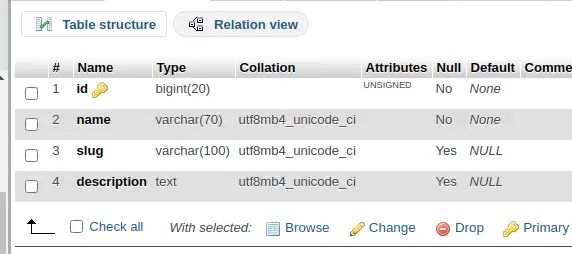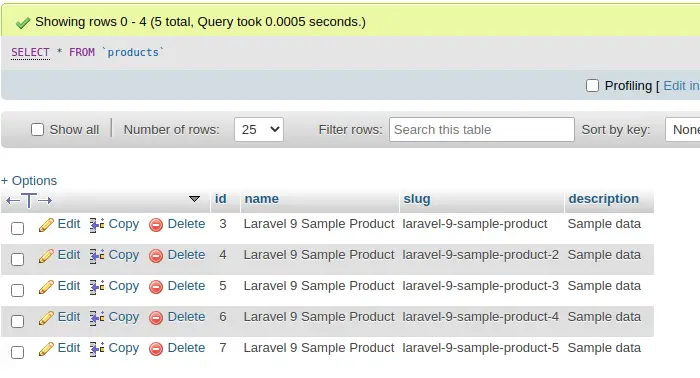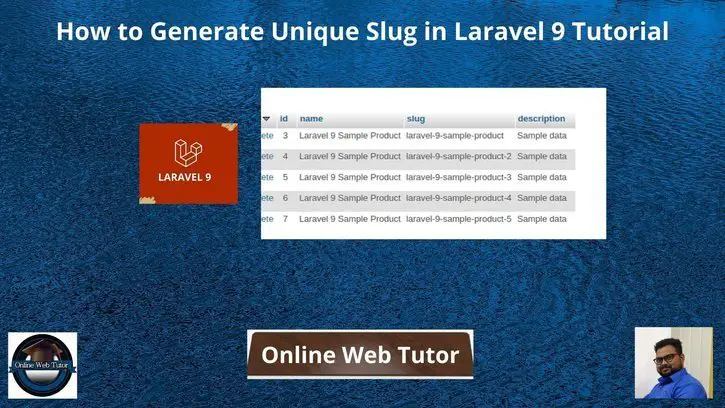Inside this article we will see the concept of generate unique slug in laravel 9. It will be very easy to get the concept and implement in laravel 9 application.
We can use this same concept of slug generation with other versions of laravel as well. Inside this tutorial also we will understand how to generate unique slug in laravel using eloquent model events.
This concept is useful when you do insertion of same row but you want slug should be different. Then this concept will help you for this.
Learn More –
- How To Change Email Subject in Laravel 9 Tutorial
- How to Check If a File Exists in Laravel 9 Tutorial
- How To Get HTTP Hostname In Laravel 9 Tutorial
- How To Install Laravel 9 on Ubuntu Step by Step Tutorial
Let’s get started.
Laravel Installation
Open terminal and run this command to create a laravel project.
composer create-project laravel/laravel myblogIt will create a project folder with name myblog inside your local system.
To start the development server of laravel –
php artisan serveURL: http://127.0.0.1:8000
Assuming laravel already installed inside your system.
Create Database & Connect
To create a database, either we can create via Manual tool of PhpMyadmin or by means of a mysql command.
CREATE DATABASE laravel_app;
To connect database with application, Open .env file from application root. Search for DB_ and update your details.
DB_CONNECTION=mysql DB_HOST=127.0.0.1 DB_PORT=3306 DB_DATABASE=laravel_app DB_USERNAME=root DB_PASSWORD=root
Create Model & Migration
Open project into terminal and run this command to create model and migration file.
Model file is one which helps application to communicate with database table and migration file creates schema of table.
$ php artisan make:model Product -mThis command create two different files – a Model file and a Migration file. -m is for migration file.
- Proudct.php model file inside /app/Models folder.
- 2022_03_15_030914_create_products_table.php Migration file inside /database/migrations.
Open {timestamp}_create_products_table.php migration file and write this update code.
<?php
use Illuminate\Database\Migrations\Migration;
use Illuminate\Database\Schema\Blueprint;
use Illuminate\Support\Facades\Schema;
return new class extends Migration
{
/**
* Run the migrations.
*
* @return void
*/
public function up()
{
Schema::create('products', function (Blueprint $table) {
$table->id();
$table->string("name", 70);
$table->string("slug", 100)->nullable();
$table->text("description")->nullable();
});
}
/**
* Reverse the migrations.
*
* @return void
*/
public function down()
{
Schema::dropIfExists('products');
}
};
Run Migration
Back to terminal and run this artisan migrate command to run migrations.
$ php artisan migrateTable: products

Open Product.php from /app/Models folder and write this following code into it.
<?php
namespace App\Models;
use Illuminate\Database\Eloquent\Factories\HasFactory;
use Illuminate\Database\Eloquent\Model;
use Illuminate\Support\Str;
class Product extends Model
{
use HasFactory;
protected $fillable = [
'name', 'slug', 'description'
];
public $timestamps = false;
/**
* Boot the model.
*/
protected static function boot()
{
parent::boot();
static::created(function ($product) {
$product->slug = $product->createSlug($product->name);
$product->save();
});
}
/**
* Write code on Method
*
* @return response()
*/
private function createSlug($name)
{
if (static::whereSlug($slug = Str::slug($name))->exists()) {
$max = static::whereName($name)->latest('id')->skip(1)->value('slug');
if (isset($max[-1]) && is_numeric($max[-1])) {
return preg_replace_callback('/(\d+)$/', function ($mathces) {
return $mathces[1] + 1;
}, $max);
}
return "{$slug}-2";
}
return $slug;
}
}
whereSlug is dynamic method created from the name of column. where{ColumnName}. whereName() is for name column.
Here,
We are checking that slug should be unique of every inserted product.
Examples for some slug
<meta http-equiv="content-type" content="text/html; charset=utf-8">laravel-9-product-upload
laravel-9-product-upload-2
laravel-9-product-upload-3
laravel-9-product-upload-4Create Controller
Back to terminal and run this artisan command
$ php artisan make:controller ProductControllerIt will create a file ProductController.php inside /app/Http/Controllers folder.
Open controller file and write this code into it.
<?php
namespace App\Http\Controllers;
use Illuminate\Http\Request;
use App\Models\Product;
class ProductController extends Controller
{
public function addProduct()
{
$product = Product::create([
"name" => "Laravel 9 Sample Product",
"description" => "Sample data"
]);
dd($product);
}
}
- Create & Save product into database table “products”.
- Automatically the boot method what we have created in Product model will be used. We have used the concept of model event static::created
- Product::create(), we have passed name and description value and also slug value automatically comes from model and will insert into table.
Add Route
Open web.php from /routes folder. Add this route into it.
//...
use App\Http\Controllers\ProductController;
Route::get('product', [ProductController::class, 'addProduct']);
//...
Application Testing
Run this command into project terminal to start development server,
php artisan serveURL – http://127.0.0.1:8000/product
When you hit this url multiple times, it will insert new product rows inside products table. One thing we can notice is here about generated slug value. It is unique for all rows.

We hope this article helped you to learn about Generate Unique Slug in Laravel 9 in a very detailed way.
If you liked this article, then please subscribe to our YouTube Channel for PHP & it’s framework, WordPress, Node Js video tutorials. You can also find us on Twitter and Facebook.
